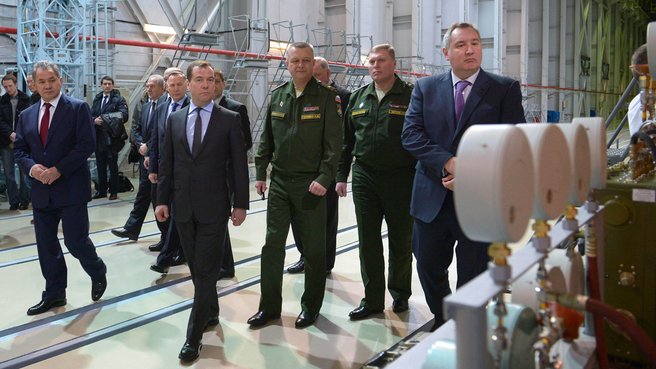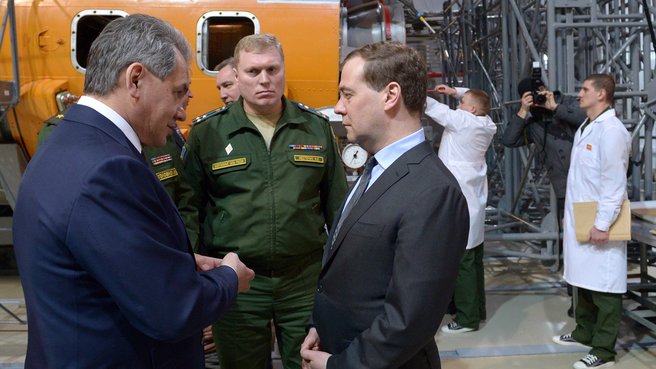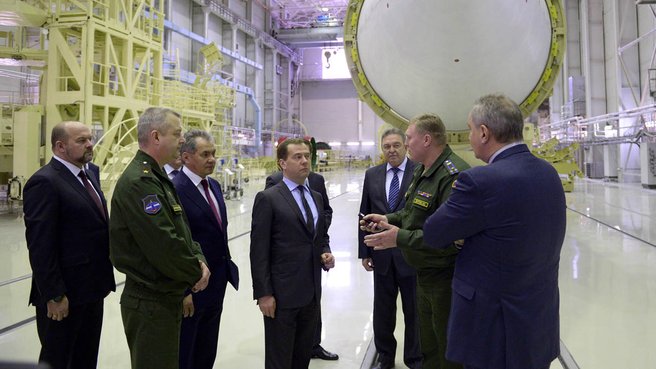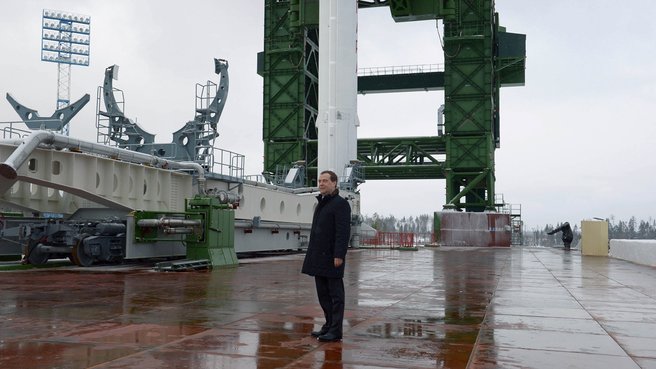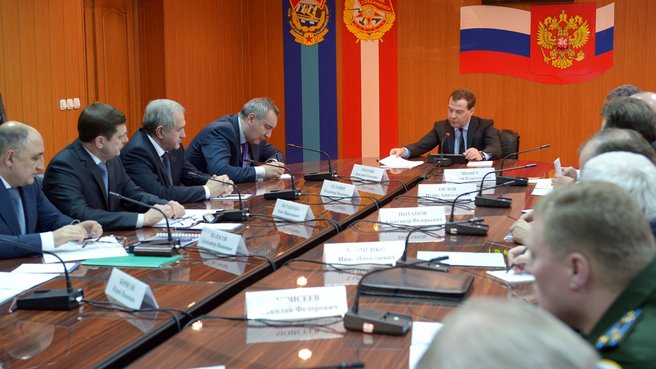Dmitry Medvedev's working visit to the Plesetsk Space Port.
Touring the Plesetsk Space Port
Briefing by Deputy Prime Minister Dmitry Rogozin
Dmitry Medvedev tours the Plesetsk Space Port in the Arkhangelsk Region.
The decision to build the Plesetsk Space Port was taken in 1957. It is a state-of-the-art research and technology facility comprising starting complexes with booster launchers, engineering centres for space rockets and spacecraft, a multifunctional fueling-and-neutralization station for refueling launch vehicles, boosters and spacecraft with rocket fuel components.
The Prime Minister was shown maintenance checkout facilities on Soyuz- 2 and Angara launch vehicles located at the Plesetsk Space Port, as well as the Angara launch complex currently under construction.
The rocket system is designed to launch unmanned spacecraft for military, socioeconomic and scientific purposes weighing from two to 24.5 tonnes into low, medium, high circular and elliptical orbits, including sun-synchronous and stationary orbits.
The complex will be an integral part of the national spacecraft launch vehicle system, which uses solely the Russian research and industrial potential.
Dmitry Medvedev was also advised of the Angara test schedule. The first rocket launch is to take place in the second quarter of this year.
***
Following the tour, the Prime Minister held a meeting on progress in creating the Angara space rocket complex.
Transcript of the beginning of the meeting:
Dmitry Medvedev: Today we’ve reviewed (many of those present do this regularly, but not often in such a group…) the construction of the Soyuz and Angara launch vehicles at the Plesetsk Space Port. A month and a half ago, on 28 December 2013, Russia successfully launched its light Soyuz-2-1v carrier rocket, which placed a satellite into a low-earth orbit. I’d like to emphasise that this was the first launch of a Russian rocket since Soviet times, which is an outstanding event in itself.
Naturally, in future we’ll launch carrier rockets from the Vostochny Space Port as well. Mr Rogozin, I understand you are going there soon? Good.
Dmitry Medvedev: Angara space rocket complex guarantees our defence capability and security, peaceful space exploration and Russia’s participation in international space cooperation, which is very important for us as well.
Now let’s discuss the creation of the Angara space rocket complex, which will be able to put all space vehicles into orbit. It guarantees our defence capability and security, peaceful space exploration and Russia’s participation in international space cooperation, which is very important for us as well.
I hope that the Angara launch vehicle’s specifications will make it possible to compete with the best international rockets. The rocket system was completely designed and manufactured in Russia using environmentally friendly fuel components (oxygen and kerosene). But, most importantly, we have created a rather impressive science and technological potential that will be in high demand in efforts to upgrade all rockets, spacecraft and the required infrastructure.
Last year, the Plesetsk Space Centre successfully assembled and launched a number of spacecraft. In fact, these events were quite important for those who live and work here. Right now, I’m not talking about national significance, but we shouldn’t underestimate the local significance of these events. This year, we’ll launch the first Angara-type rocket, and to be honest this is the point of our meeting.
Dmitry Medvedev: "I hope that the Angara launch vehicle’s specifications will make it possible to compete with the best international rockets. The rocket system was completely designed and manufactured in Russia using environmentally friendly fuel components".
In this context, the Aerospace Defence Force has to accomplish a number of objectives. A lot will depend on the accurate and well-coordinated actions of the space centre’s launch crews, the research and development agencies, whose representatives are present here, and the equipment manufacturers.
Let’s get started. First, I’d like to ask Alexander Kirilin, the Director General of our Progress State Research and Production Space Centre, to take the floor. After that we will discuss the issues of the Angara launch vehicle research and development project behind closed doors.
Please.
Alexander Kirilin (Director General of the Progress State Research and Production Space Centre): Mr Medvedev, thank you for this opportunity to speak on this issue.
Indeed, the Soyuz-2.1C launch vehicle, the first Russian-made light-weight, liquid-propellant rocket, lifted off on 28 December. It took us only three and a half years to develop it after the Defence Ministry decided to build this launch vehicle in late 2009. We managed to develop this system so quickly because we promptly submitted our project to the Defence Ministry.
Alexander Kirilin: The Soyuz-2.1C, the first Russian-made light-weight, liquid-propellant rocket, lifted off on 28 December. It took us only three and a half years to develop it after the Defence Ministry decided to build this launch vehicle.
As for the different models and variants that you have seen today, I would like to note that the first Soyuz-2.1A launch vehicle lifted off on 8 November 2004. We have had 15 successful launches to date. Flight tests of this launch vehicle have already been completed, and we are now drafting documents for commercial use. And the Russian Federal Space Agency (Roskosmos) has selected this launch vehicle as the first rocket to lift off from the Vostochny Space Centre. Compared to older launch vehicles, we have increased the payload capacity of this rocket by 400 kg.
The Soyuz-2.1B was the next-generation medium-weight launch vehicle. The first one lifted off in December 2006. We have increased this rocket’s payload capacity by 1,000 kg. All three launch vehicles, the Soyuz-2.1A, B and C, were developed within the current Russian space programme.
I’d like to note that this technical facility we’ve seen today is a multi-role technical complex for testing and preparing all rockets for launch. This complex will help us ensure effective launches. This facility can be used to test, assemble and launch all three types of rockets.
Alexander Kirilin: The Soyuz-2.1C launch vehicle – is the first 3D rocket project, developed by our professionals and young specialists.
Mr Medvedev, I would also like to say a few more words about the Soyuz-2.1C launch vehicle. This is the first 3D rocket project, developed by our professionals and young specialists …
Dmitry Medvedev: This is the first but not the last project because from now on you will design everything in 3D format. It’s impossible to imagine anything else at this point.
Alexander Kirilin: Yes. And of course young people have started applying for jobs in our sector, and they are quite enthusiastic about working in this area. The Volga booster was launched as part of the Soyuz-2.1C rocket for the first time. This booster was our initial project, and we submitted this operational version and our proposals for its use to the Defence Ministry. This booster lifted off for the first time during this launch. Thank you, and that concludes my report.
Dmitry Medvedev: Thank you very much. And we’ll say nothing more about the Angara launch vehicle; we’ll simply discuss everything quietly to maintain the plot line. I’d also like to suggest that everyone speak briefly, so we can keep an eye on the national hockey team match.
<…>
***
Briefing by Deputy Prime Minister Dmitry Rogozin after a meeting on the development of the new Angara launch vehicle system
Question: Did you adopt any decisions after the meeting? What should we expect in the near future?
Dmitry Rogozin: Participants in the meeting chaired by the Prime Minister were extremely pragmatic. In effect, specific decisions were linked with the Government’s stance regarding various incentives to ensure the development of the space rocket industry. Today, we have examined issues regarding the location of launch facilities for orbiting various payloads, as well as space rocket types. Payloads remain the only important issue.
So, there are three important aspects. Expanded construction of space centres is the first aspect, and the Prime Minister has supported the idea of drafting a new federal targeted programme for the development of space ports over a ten-year period, staring in 2016. This can be explained by the fact that the current ten-year programme is set to expire in 2015. There are plans to complete the second launch pad at the Vostochny (Eastern) Space Port in the future and, of course, to build additional facilities here, at the Plesetsk Space Port. In effect, this will provide Russia with its required space launch potential.
Today, we have also discussed the second aspect, and we have made specific decisions in this area. Unfortunately, space-system and spacecraft manufacture deadlines have often been delayed over the past few years. In fact, this has already become a common occurrence. We also fail to implement specific programmes needed to provide the entire range of space-launch market services. Currently, Russia accounts for only 3% of the global space-launch market services. What does this mean? This means that we continue to act as an outstanding space “taxicab.” In effect, we have a system of launch vehicles, including the Proton, Soyuz and Rokot space rockets, and Russia will receive the Angara launch vehicle soon. And we have many other launch vehicles, too. But Russia has far fewer orbital spacecraft. In fact, it has several times less spacecraft in orbit than the United States does. Therefore, we are losing the race in such areas as mapping, cartography, remote sensing satellites, navigation, communications, etc. And these are the most profitable civilian space sectors. Today, the Prime Minister has therefore supported the idea of drafting a special Government decision that would stipulate rigid deadlines and penal sanctions for spacecraft manufacturers. This will allow us to meet specific timeframes and deadlines.
As for the Angara launch vehicle, you can see that various deadlines have been violated several times. In effect, work on the Angara rocket was started only 10 years ago. We are now working on schedule, and we know that a light-weight Angara launch vehicle will lift off at the end of the second quarter, and that a heavy-duty Angara rocket will be launched in late 2014. The same concerns other major projects, including defence projects that were examined behind closed doors today.
But, speaking of spacecraft, we, of course, need an entirely different type of discipline and responsibility here. Of course, we link some hopes and our serious expectations with current efforts to establish the United Rocket and Space Corporation because our Soviet-era space rocket industry seems to be rather bloated and technologically backward. Therefore, the United Rocket and Space Corporation has already been virtually established, and its CEO should be appointed soon. This corporation is expected to consolidate our space assets.
Here is one example: the United States has four spacecraft manufacturers, while nine Russian companies work in the same field. No one needs this redundancy. On the contrary, it would be better to consolidate these assets, primarily the creative, research and development potential, to re-equip these enterprises and to enable them to manufacture spacecraft for the Russian Federation, and to sell them on a competitive basis. This is a highly profitable business. Therefore, the Government decision will aim to create a rigid timeframe for monitoring the manufacture of civilian and dual-purpose spacecraft and their launches. So, this is a brief summary of the results of our work.
Question: I would like to ask a question that is closely related to this subject. Will the state purchase the shares of the Sea Launch project, and when?
Dmitry Rogozin: The Government has instructed the Russian Federal Space Agency and the Korolyov Rocket and Space Corporation Energia to submit a joint financial and economic feasibility study of the Sea Launch project. As you know, the Sea Launch project is, of course, unique in itself. Unlike our northern testing sites and space centres, this project makes it possible to launch Russian-Ukrainian Zenit rockets with heavier payloads from southern latitudes. But this project is based in the United States. This means that Russia is unable to launch its own space satellites in line with its national interests through the Korolyov Rocket and Space Corporation Energia, where it has a 38% stake. In effect, we will have to notify US authorities of our military or dual-purpose satellite launches. We consider this situation to be impossible. So this issue is rather complicated.
If the Government receives all the required information – first of all, I am talking about the entire volume of financial problems linked with the Sea Launch project – then we will be able to decide whether it is appropriate to retain control over this space launch facility or not. But something is telling me that, if we decide to go ahead with this project, then this platform should not be based in the United States.
Question: Does this mean that the Sea Launch facility will relocate elsewhere, if you have a choice, to put it bluntly?
Dmitry Rogozin: In this case this facility will likely relocate to the Russian Far East.
Question: I have a question about the Amur-2 express. The Russian company believes that some tenders are unfair. Will their results be annulled?
Dmitry Rogozin: I have advised Minister of Communications and Mass Media Nikolai Nikiforov to reassess the procedure for conducting this tender. Mr Nikiforov has told me that we will, most likely, have to re-examine this issue. On the whole, I believe that, if we are able to manufacture competitive products – specifically, Russian-made communications satellites – then it would be inappropriate to rush about and purchase them abroad because this prompts too many questions to the organisers. The rather biased tender was organised precisely in favour of foreign producers. But this is once again linked with the above-mentioned issue – that of improved product quality – as well as more stable and sustained manufacture of multi-purpose Russian spacecraft. Therefore, I believe that we will completely answer this question in the near future. We have our own research and development agency, specifically, the Information Satellite Systems – Reshetnyov Company based in Krasnoyarsk. They are ready to make and present a satellite with similar parameters that would be no worse than European-made satellites.
Thank you.
